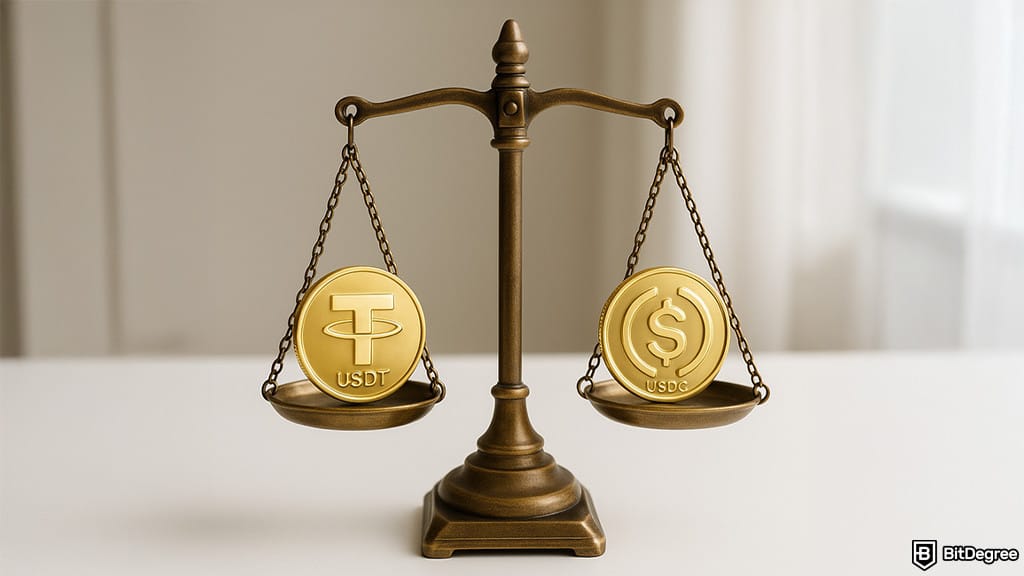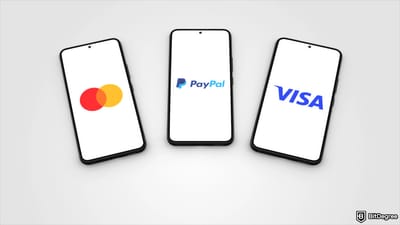Key Takeaways
- Many crypto enthusiasts consider Tether, USD Coin, Dai, TrueUSD, and Binance USD to be among the best stablecoin options;
- When looking for a stablecoin, you should take into account several factors, including liquidity, transparency, application, and regulatory compliance;
- Stablecoins aren't entirely risk-free, so it’s essential to do extensive research before adding them to your portfolio.
Stop overpaying - start transferring money with Ogvio. Join the waitlist & grab early Rewards NOW! 🎁
Looking to add a touch of stability to your crypto portfolio? Stablecoins might be the answer! Here, I've compiled a list of the best stablecoin options based on their popularity and the insights of crypto enthusiasts in the community.
Keep in mind that I'm not here to provide financial advice! My aim is to guide you in the right direction so you can DYOR (do your own research) or seek guidance from a financial advisor.
If you've done your research and you're thinking of including them in your portfolio, make sure to use a trusted exchange like Binance, Bybit, or Kraken for smooth and secure transactions.

Did you know?
Subscribe - We publish new crypto explainer videos every week!
What is Litecoin? LTC Easily Explained (ANIMATED)
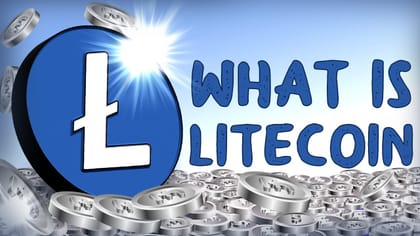

Table of Contents
- 1. Top Stablecoins List
- 1.1. Tether (USDT)
- 1.2. USD Coin (USDC)
- 1.3. Dai (DAI)
- 1.4. TrueUSD (TUSD)
- 1.5. Binance USD (BUSD)
- 1.6. USDD (USDD)
- 1.7. PayPal USD (PYUSD)
- 1.8. Tether Gold (XAUt)
- 1.9. Ethena (USDe)
- 1.10. Frax (FRAX)
- 2. Choosing the Best Stablecoins to Buy: Key Evaluation Factors
- 3. Stablecoins Explained
- 4. Advantages and Disadvantages of Stablecoins
- 5. Best Stablecoin Management Tips for Beginners
- 6. Conclusions
Top Stablecoins List
Let's immediately dive into some of the best stablecoin options in the market! I've put together this selection based on their popularity and what experts in the crypto space are saying, aiming to provide you with valuable insights.
Latest Deal Active Right Now:Tether (USDT)
Let’s start with the one that almost everyone in crypto has heard of—Tether. Also commonly known by its ticker symbol USDT, Tether is the oldest and the most popular stablecoin on the market.
One reason for its popularity is that it manages to maintain its 1:1 peg to the US dollar, which means that one USDT is always intended to be worth exactly one dollar. This helps the token mitigate market volatility and makes it a safer form of currency for individual traders and businesses.

Tether’s popularity also largely stems from its extensive liquidity and widespread adoption. You’ll find Tether on nearly every major exchange, making it convenient to trade or convert into other assets.
On top of that, Tether tokens are widely accepted as digital currency across various major blockchains, including Algorand, Avalanche, Polygon, and Ethereum.
According to Tether, each USDT token is backed by reserves that include a mix of fiat currencies, cash equivalents, and other assets to keep its value stable. However, it's important to know that Tether has been under some scrutiny regarding the transparency and makeup of these reserves.
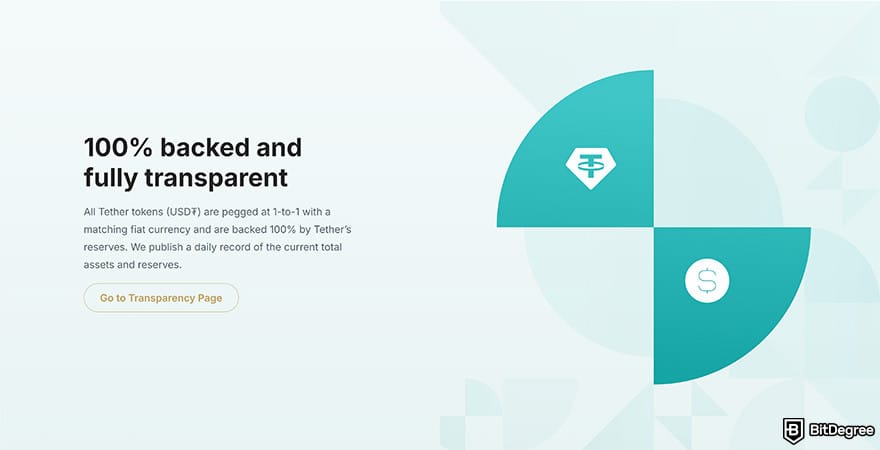
Despite that, Tether remains one of the best stablecoin options for those prioritizing liquidity and easy access.
While Tether is primarily used as a digital currency for online transactions and to mitigate volatility, it can also be held long-term by those who prefer to store their funds in crypto.
In addition, you can also make passive income by earning yield on your Tether tokens using crypto lending sites. Just keep in mind that there are risks involved in these types of ventures.
All in all, while it's possible to profit from holding Tether, its main advantages are its widespread use and stable value. So, if you’re looking for the best stablecoin that offers seamless transactions and protection against market volatility, Tether can be an attractive option.
Where to buy USDT: Binance, Bybit, Kraken, etc.
USD Coin (USDC)
USD Coin has quickly risen through the ranks and is considered by many in the community to be one of the best stablecoin options. Launched in 2018, USDC is pegged 1:1 to the US dollar, making it reliable for payments and hedging against volatility.
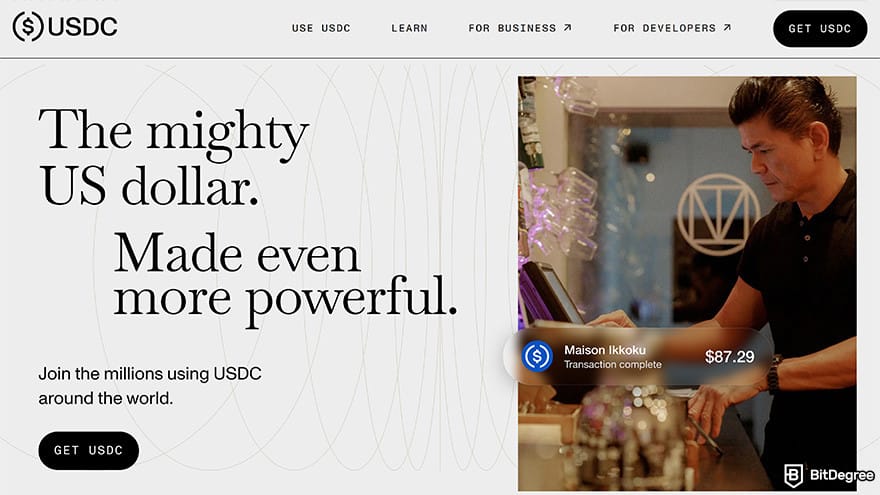
USD Coin is fully backed and managed by the Centre consortium, which includes companies like Coinbase and Circle. The Centre ensures that USD Coin is fully collateralized, meaning every USDC token in circulation is backed by an equivalent amount of US dollars held in reserve.
On top of that, USD Coin is known for its transparency in the crypto space. It undergoes regular audits to verify that its reserves fully back the circulating tokens. This level of transparency has earned the trust of both institutions and everyday users, making the token a preferred stablecoin for securely storing value.
Additionally, USDC has gained significant traction in the DeFi space. It can be used as collateral for loans, liquidity pool assets, and yield farming, offering opportunities for potential additional income.

With its strong transparency and versatile use cases, USDC is an appealing choice for those who prioritize a stablecoin that excels in both reliability and transparency. Its wide adoption in transactions and DeFi makes it a versatile solution for various financial needs.
Where to buy USDC: Coinbase, Kraken, Binance.
Dai (DAI)
Dai stands out from other stablecoins because it operates on a fully decentralized model. Rather than being backed by traditional dollars in a bank, Dai maintains its value through complex smart contract protocols on the Ethereum blockchain.
To create a DAI token, you must lock up Ethereum or other approved cryptocurrencies in a smart contract called a Collateralized Debt Position (CDP). Once minted, the resulting token can be used for transactions or traded on exchanges.

Dai maintains its price stability through a carefully balanced mechanism of algorithms and incentives that adjust its supply based on market demand.
For example, if Dai’s price rises above $1, users can generate more tokens by depositing additional collateral. On the other hand, if the price falls below $1, users are incentivized to buy and burn Dai, reducing its supply and driving its value back up.
By following this decentralized approach, Dai aims to maintain low volatility and withstand hyperinflation, providing economic freedom and opportunities to users all over the world.

DAI's stability is also maintained by the MakerDAO community, which votes on protocol adjustments to keep its peg. This decentralized governance gives the stablecoin a unique advantage, especially for those looking to avoid centralized control and its associated risks.
As a result, many DeFi enthusiasts consider DAI to be one of the top stablecoins due to its decentralized governance model. It’s a good choice for anyone who wants a stable cryptocurrency with various applications without having to rely on a single authority.
Where to buy DAI: Kraken, Bybit, Coinbase, etc.
TrueUSD (TUSD)
Another contender among the best stablecoins, according to many enthusiasts, is TrueUSD.
Launched in 2018 by TrustToken, TrueUSD claims to be the first stablecoin to use smart contracts for minting and real-time on-chain verification of its reserve coverage.
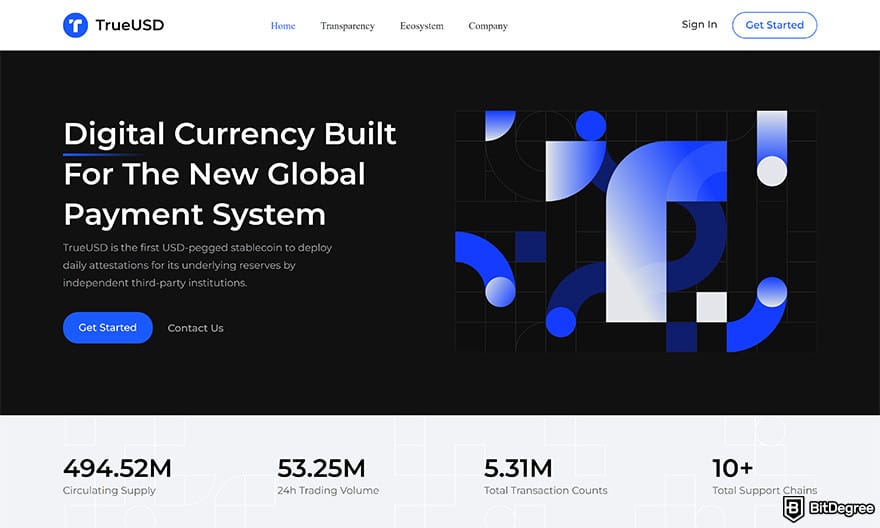
TrueUSD ensures transparency by providing daily attestations from an independent accounting firm to verify these reserves. By doing this, TrueUSD hopes to promote both trust and accountability.
In addition, TrueUSD is fully backed by US dollars held in escrow accounts managed by third-party trust companies. This setup ensures that each TUSD token in circulation is matched by a corresponding dollar in reserve.
As a result, it allows TrueUSD to reduce counterparty risk and make it a reliable option for storing assets against market volatility.

On top of that, TUSD is developed on the Ethereum blockchain, enabling fast and cost-effective transactions with low fees. This perk makes the coin a preferred choice for moving funds quickly, especially during volatile market conditions.
In addition to transparency and speed, TrueUSD is widely integrated into various DeFi platforms. It allows you to participate in DeFi protocols without needing a traditional bank account, thus opening up access to new financial opportunities.
These features make TUSD an attractive option to add to your stablecoins list to look out for.
Where to buy TUSD: Binance, Kraken, etc.

Did you know?
Subscribe - We publish new crypto explainer videos every week!
How to Pick the Right DeFi dApp? (Dos and Don’ts Explained)


Binance USD (BUSD)
As the name suggests, Binance USD is a stablecoin issued by Binance, one of the world’s largest cryptocurrency exchanges. In partnership with Paxos, a trust company, Binance ensures that each BUSD token is backed by dollar reserves.
One cool thing about Binance USD is that it's tightly integrated within the Binance ecosystem. So, if you use the exchange frequently, you'll enjoy smooth transactions, low fees, and access to a wide variety of trading pairs.
Aside from Binance, you can use Binance USD to trade, make payments, and purchase goods and services across different platforms. This versatility makes it one of the best stablecoins to keep an eye on.

On top of that, BUSD is fully regulated by the New York State Department of Financial Services (NYDFS). This means that BSUD complies with applicable laws and regulations. This level of oversight offers peace of mind for those who prioritize legal security in their financial transactions.
Binance USD can be an attractive stablecoin option, especially if you’re an active Binance user. It’s also a good choice for anyone looking for a stablecoin that's versatile and regulated.
Where to buy BUSD: Binance, Coinbase, etc.
USDD (USDD)
The USDD stablecoin, issued by the TRON DAO Reserve, is another interesting option to keep an eye on in the market. It's designed to be versatile and features an incentive mechanism and adaptive monetary policy to maintain its price stability.
Thanks to its decentralized protocol, USDD stability has opened up various use cases for cryptocurrency, making it more accessible and impactful for both blockchain technology and the global economy.

It's also worth noting that USDD recently got a major upgrade, becoming the first over-collateralized decentralized stablecoin. This upgrade secures its value through a robust collateral pool, including highly liquid assets like Bitcoin (BTC), TRON (TRX), and Tether (USDT).
Additionally, the TRON DAO Reserve maintains a collateral ratio well above 100%, further enhancing the coin's stability and security. This improvement has strengthened confidence in the stablecoin's resilience, positioning USDD as one of the best stablecoins to watch in the ever-changing cryptocurrency market.
Where to buy USDD: Coinbase, KuCoin, etc.
PayPal USD (PYUSD)
PayPal USD is gaining recognition as one of the best stablecoins in the crypto space for its strong backing and smooth integration into the digital payment landscape.
Created by PayPal in partnership with Paxos Trust Company, PYUSD is fully backed by US dollar deposits, short-term US treasuries, and other liquid assets, maintaining a stable 1:1 value with the US dollar. This stability is further ensured through monthly audits conducted by an independent third-party accounting firm.
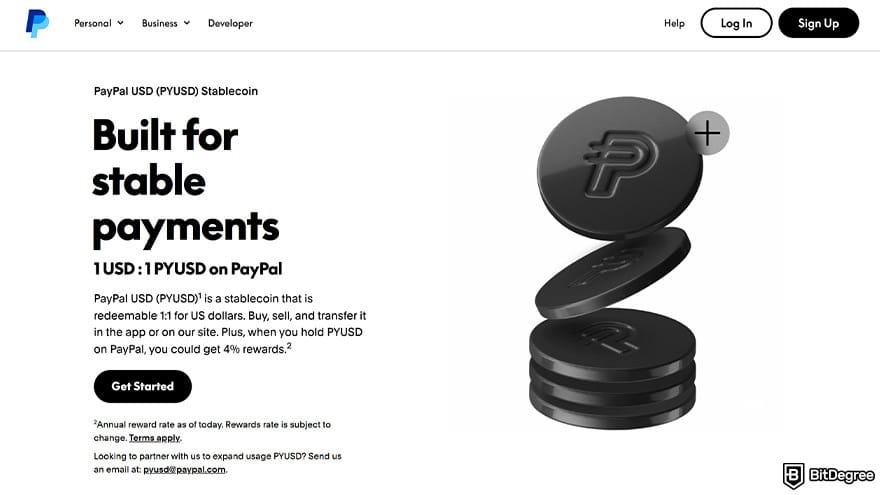
On top of that, PYUSD seamlessly fits into PayPal's vast payment network, making it an ideal choice for various transactions—whether you're sending money to a friend or handling business payments.
Where to buy PYUSD: Kraken, Coinbase, PayPal, etc.
Tether Gold (XAUt)
Tether Gold is a popular gold-backed stablecoin that offers the best of both worlds: the stability of gold and the convenience of cryptocurrency. Each XAUt represents one fine troy ounce of physical gold that is securely stored in Swiss vaults. The gold backing is regularly audited to ensure transparency and bolster trust in the token’s value.

Tether Gold is also user-friendly, allowing XAUt tokens to be divided into increments as small as 0.000001 troy ounces, so you can hold amounts that fit your needs.
The token makes gold portable, enabling you to convert your assets into digital tokens on various exchanges and take them anywhere. Since gold is a relatively stable asset, many enthusiasts consider XAUt one of the best stablecoins for value storage in the market.
Where to buy XAUt: decentralized exchanges.
Ethena (USDe)
Ethena is a synthetic dollar protocol developed on Ethereum. It offers a crypto-native monetary solution that operates independently of traditional banking systems. One of its key features is the "Internet Bond," which is a globally accessible savings asset.
The protocol's synthetic dollar (USDe) provides a censorship-resistant, scalable, and stable alternative for crypto-native transactions. This stability is achieved through delta-hedging staked Ethereum collateral, ensuring that USDe remains fully transparent and backed on-chain.
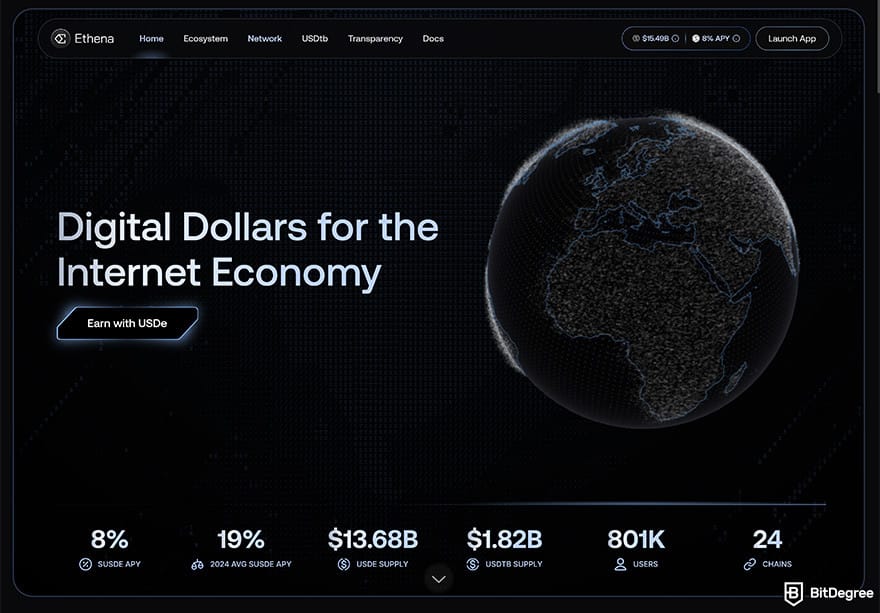
On top of that, the Internet Bond combines yields from staked Ethereum and profits from perpetual and futures markets to create the first on-chain, crypto-native "bond." This bond offers a dollar-denominated savings option for users in authorized jurisdictions.
Where to buy USDe: KuCoin, decentralized exchanges, etc.

- Secure and reliable
- Accepts fiat currencies
- Lots of trading options
- Reputable exchange
- Accepts fiat currencies
- Offers various trading options

- Huge trading variety
- Regulation-compliant around the globe
- Fair trading fees
- Beginner-friendly
- A wide array of features
- Vast number of different crypto coins & tokens

- Beginner-friendly
- Secure
- Decent trading and withdrawal fees
- Crypto.com Visa Card
- Automated tools & bots
- Ecosystem synergy with CRO
Frax (FRAX)
Frax has introduced a new category called fractional-algorithmic, pioneering a decentralized stablecoin model that uniquely combines collateralization with algorithmic controls. The token aims to be a highly scalable, decentralized form of algorithmic money, offering an alternative to fixed-supply digital assets like Bitcoin.
The fractional-algorithmic model takes a hybrid approach where part of FRAX's supply is backed by collateral, while another part is maintained algorithmically. The balance between these mechanisms is determined by the market’s valuation of FRAX. When FRAX trades above $1, the system reduces the collateral ratio, and when it trades below $1, the ratio increases.
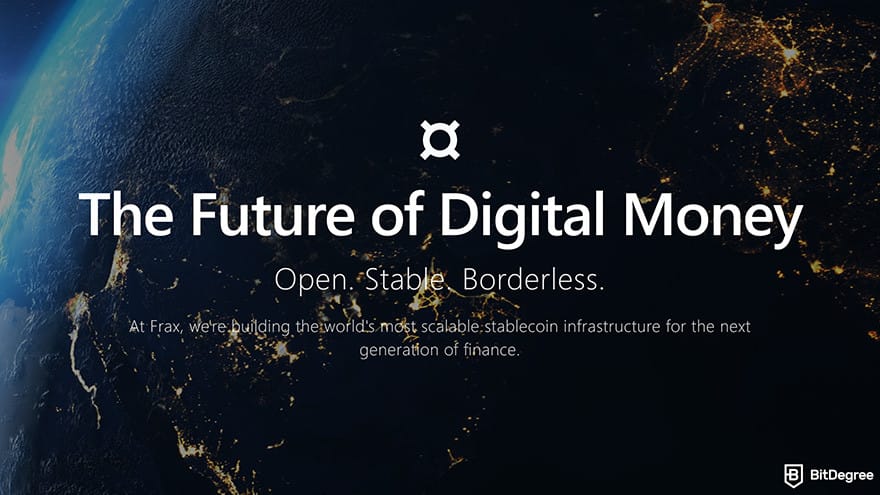
What's more, FRAX uses oracles from Uniswap and Chainlink to ensure real-time data transparency. This mechanism also enhances the token’s stability in relation to the US dollar, making FRAX an attractive option to add to your fractional-algorithmic stablecoins list to watch.
Where to buy FRAX: decentralized exchanges.
So, those are the top stablecoins based on their popularity that you might want to keep an eye on. However, this list only scratches the surface, as there are many other promising stablecoins out there.
If you want to explore further, the BitDegree crypto tracker has got your back with all the info you need. It's a cool tool to use that provides valuable insights to help you make smart decisions in the market.
Choosing the Best Stablecoins to Buy: Key Evaluation Factors
You might have checked out the tracker I suggested earlier to explore other stablecoins in the market and found some really interesting options. But with so many choices available, you might be wondering how to choose the best stablecoins to add to your portfolio.

To help with that, let’s break down the key factors you should consider before making your decision. By assessing these aspects, you’ll be able to identify the best stablecoin options that align with your goals and risk tolerance.
Liquidity
Liquidity is a key factor to consider before adding a stablecoin to your watchlist. In simple terms, liquidity refers to how easy it is to buy, sell, or trade a stablecoin without significantly impacting its price.
High liquidity means there's a large market for the stablecoin with many buyers and sellers, making transactions fast and smooth. This ensures that you can trade the coin with minimal slippage, resulting in efficient and cost-effective transactions.
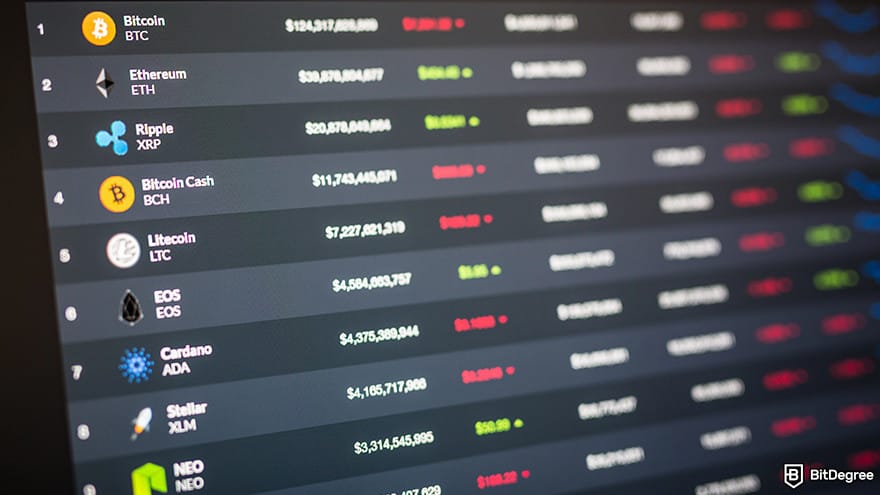
Imagine holding a stablecoin that's hard to convert to fiat or another cryptocurrency when you need to. This lack of flexibility can be frustrating and even risky, especially in volatile markets.
In terms of liquidity, Tether stands out among the top stablecoins. As of writing, it ranks third in market cap and consistently maintains high trading volume.
Transparency
Another key factor to consider when evaluating the best stablecoins is transparency, especially if you plan to hold them as a long-term store of value.
Transparency means the company is open about its reserves and those reserves fully back the coins in circulation. Usually, regular third-party audits are the standard because they can provide a clear picture of the stablecoin's financial health.
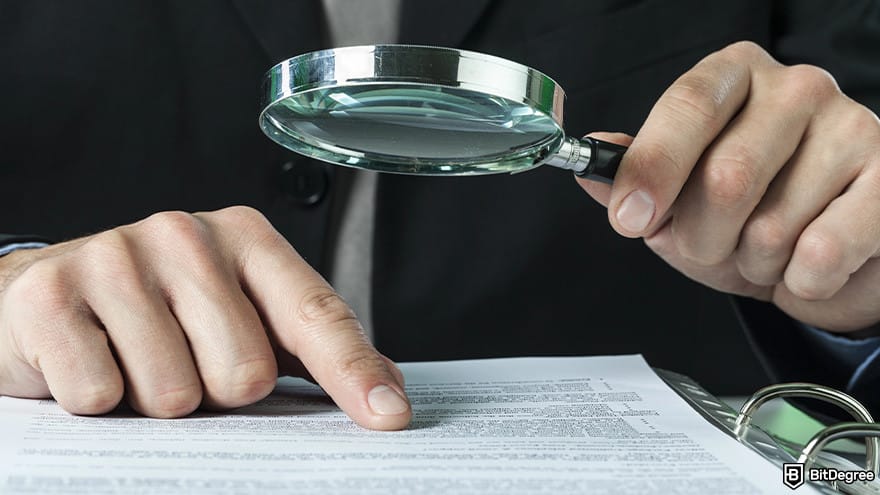
Stablecoins like USD Coin and TrueUSD attempt to build strong reputations in the community by offering detailed audit reports regularly. This practice nurtures trust and in turn, will increase adoption.
If trust and transparency are your top priorities, it’s essential to focus on stablecoins with rigorous auditing practices. Some stablecoins are backed by physical assets and fiat currency, so it’s important to know where these reserves are held and whether they fully back all the coins in circulation.
Applications
You should also consider the range of applications and use cases for each stablecoin. Some stablecoins are widely accepted across various platforms, while others are more specialized.
For instance, if you’re an active participant in DeFi, you’ll want a stablecoin that’s supported on many decentralized platforms, enabling you to engage in staking, lending, or yield farming.
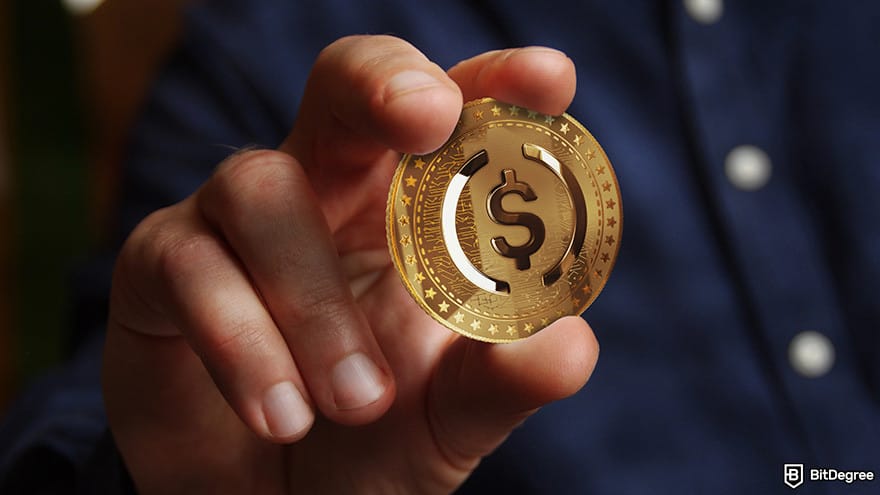
On the other hand, if you mostly want to use stablecoins for everyday transactions, look for ones with good payment options and low fees.
There are also stablecoins designed for use within their native ecosystems. Binance USD, for example, is a good option if you frequently use Binance exchange and want seamless integration within that platform.
Ultimately, choosing a stablecoin that aligns with your intended use cases ensures you get the most value and convenience from your digital assets.
Regulatory Compliance
Last but not least, remember to consider regulatory compliance when choosing a stablecoin. It's important to pick a stablecoin that follows the applicable rules to reduce the chance of running into legal or operational problems in the future.
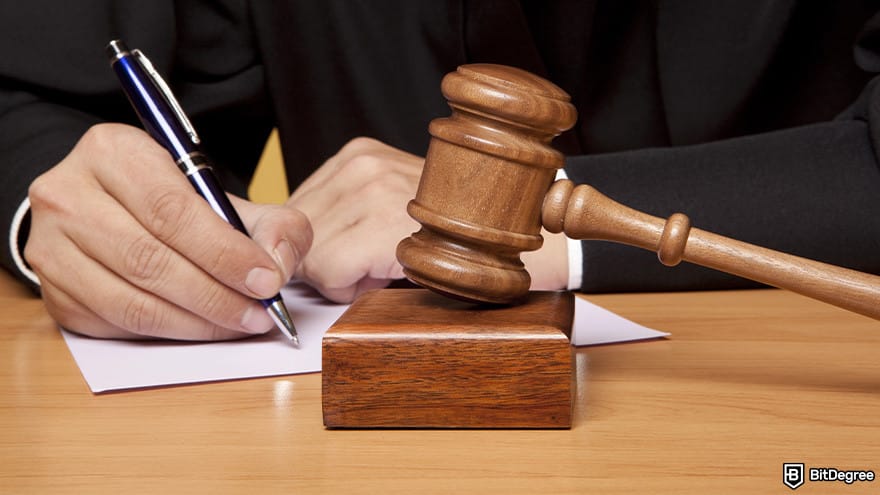
Some stablecoins are specifically designed with compliance in mind and adhere to strict regulatory standards in certain regions. For instance, Binance USD is fully regulated by the NYDFS, ensuring that it follows all relevant laws and regulations in that jurisdiction.
Choosing a regulated stablecoin can provide peace of mind, ensuring that your holdings comply with current laws and regulations.
Stablecoins Explained
I know we’ve just covered some of the best stablecoin options earlier in the article. But I realize that some of you might be new to this topic or could use a quick refresher on what a stablecoin actually is.
So, before moving forward, let's take a moment to go over the basics—what exactly is a stablecoin, and what are the different categories?
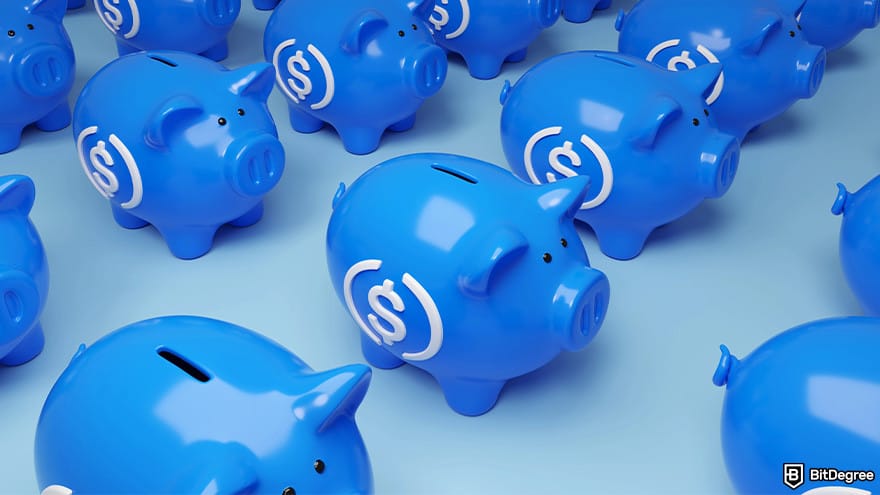
To put it simply, stablecoins are a special kind of cryptocurrency designed to maintain a stable value over time. Their value is tied to specific assets like traditional currencies or traded commodities.
Unlike Bitcoin and other cryptocurrencies, which are known for their unpredictable price changes, stablecoins are meant to have a more steady value[1]. This feature potentially makes them an efficient medium of exchange and a useful tool to mitigate overall market volatility.
Stablecoins are able to achieve this price stability by linking or "pegging" their value to reliable assets like the US dollar or gold. For instance, a stablecoin backed 1:1 by the US dollar ensures that one token should always be equal to one dollar.
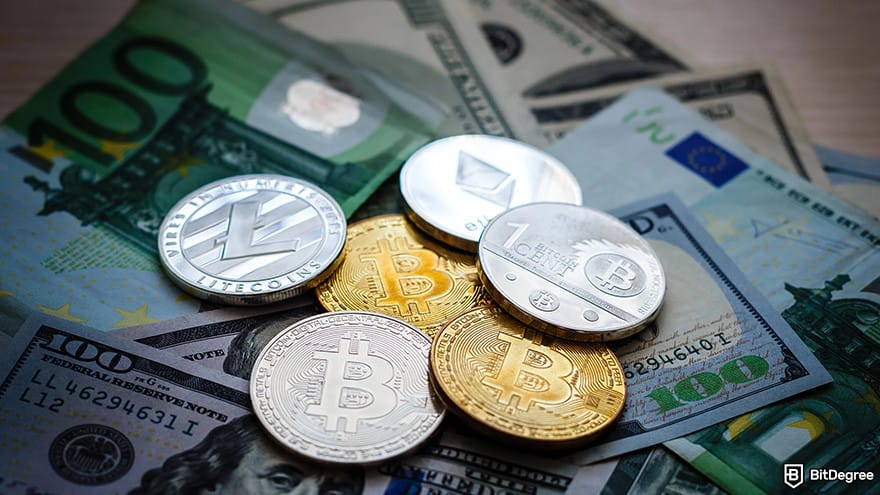
The value and the number of stablecoins have increased significantly over the years due to their popularity. Today, there are various stablecoins linked to different fiat currencies (dollar, euro, yuan) and commodities (gold, silver, real estate).
Regardless of the number, stablecoins usually fall into two categories: collateralized and non-collateralized.
Collateralized stablecoins are backed by reserve assets. For instance, each unit of a stablecoin could be supported by an actual dollar held in a bank account, ensuring its value is securely backed.

The type of assets can vary and may include fiat currencies, commodities, cryptocurrencies, and other financial instruments[2]. In some cases, this collateral is leveraged for additional opportunities, potentially improving capital efficiency.
An example of a well-known collateralized stablecoin is Tether, often referred to as the internet’s digital dollar. Each Tether token is valued at $1.00 and is backed by Tether’s dollar reserves.
On the other hand, non-collateralized stablecoins function differently. Also widely known as algorithmic stablecoins, they rely on a set of codes to maintain price stability.
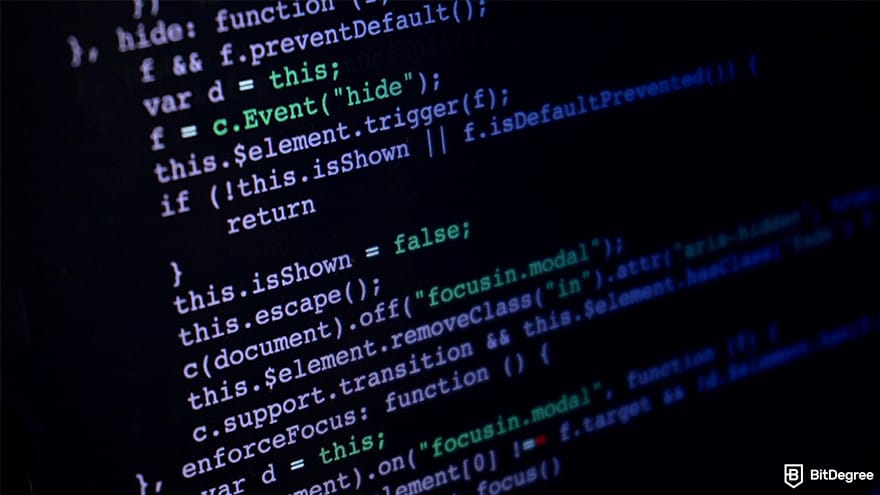
The algorithm system automatically adjusts the supply based on market demand. This means that new tokens are minted when demand rises, and some are burned when demand falls.
Also, there are usually no regulatory authorities overseeing the processes in algorithmic stablecoins. Instead, the code takes care of managing supply, demand, and maintaining the benchmark price.
A notable example of a non-collateralized stablecoin is FRAX. To maintain its value, it uses a fractional algorithmic model involving two assets: the FRAX stablecoin and the Frax Shares (FXS) governance and utility token.
While this model is innovative, it’s more complex and carries additional risks since it lacks the asset backing of collateralized stablecoins.
Advantages and Disadvantages of Stablecoins
Now that we've brushed up on our understanding, you might be eager to take the next step and add the best stablecoins to your portfolio.
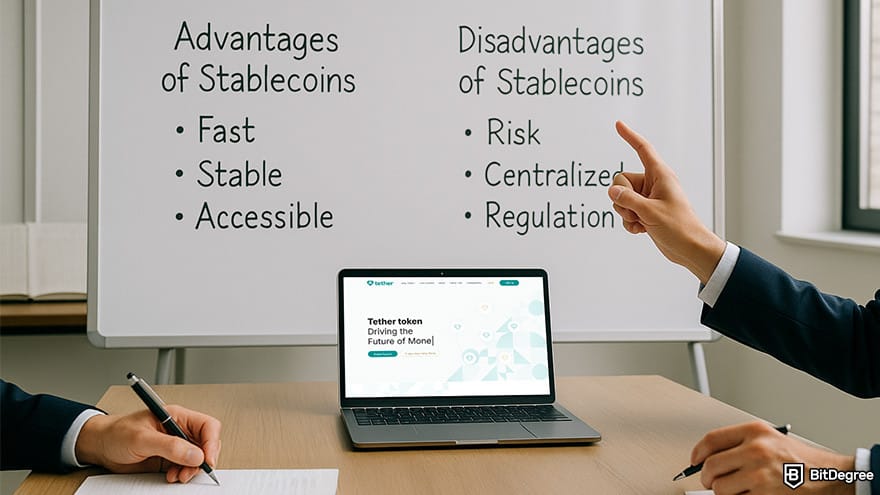
But wait! Before you do that, it's important to understand both the benefits and potential risks of holding stablecoins so you can make a smart decision that fits your financial goals and risk tolerance.
Advantages of Holding Stablecoins
Stablecoins have several benefits, which make them valuable assets in the cryptocurrency world. Here are some of their key benefits:
✓ Price Stability
One of the main attractions of stablecoins, well, is their stability. Unlike other cryptocurrencies whose prices can skyrocket one day and crash the next, stablecoins are designed to maintain a steady value.
As a result, many crypto enthusiasts consider stablecoins as an ideal medium for storing value, hedging against volatility, or handling everyday transactions.
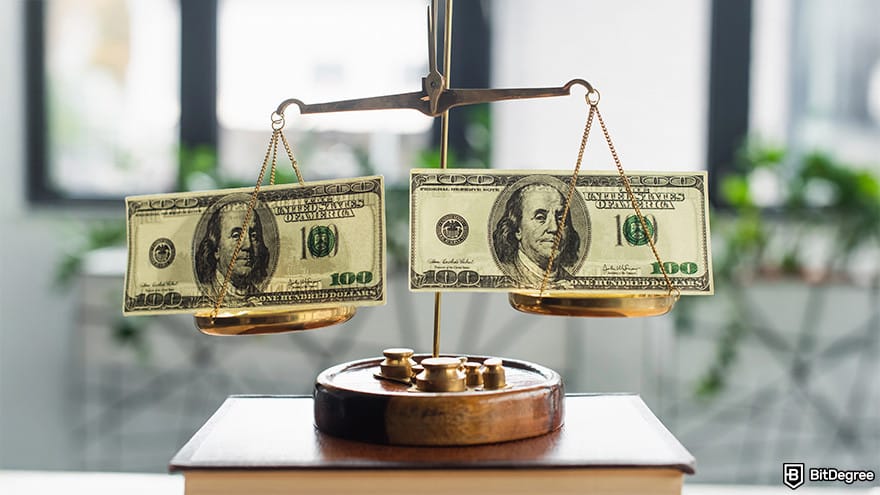
For those with a long-term focus, this stability is also particularly beneficial. It allows you to keep funds within the crypto ecosystem without being exposed to the wild price swings typical of most other cryptocurrencies.
Whether you’re temporarily parking funds between trades or holding them for the long haul, stablecoins offer the predictability that’s needed in the volatile crypto space.
✓ DeFi Integration
Stablecoins can be used as a reliable medium of exchange to interact with various DeFi protocols. For example, you can lend your stablecoins to earn interest, participate in liquidity pools, or use them as collateral to take out loans.

Their stable value allows you to try different platforms and strategies while avoiding the volatility associated with more speculative assets.
Additionally, many DeFi platforms offer attractive yields on stablecoin deposits, allowing you to earn passive income while keeping your funds relatively secure.
✓ Fast and Low-Cost Transactions
Stablecoins can be sent relatively quickly and cheaply across borders, offering a compelling alternative to traditional banking systems.
Whether you’re sending money to a friend overseas or making a payment to a business, stablecoins can be a game-changer, especially compared to the often slow and costly process of international wire transfers.
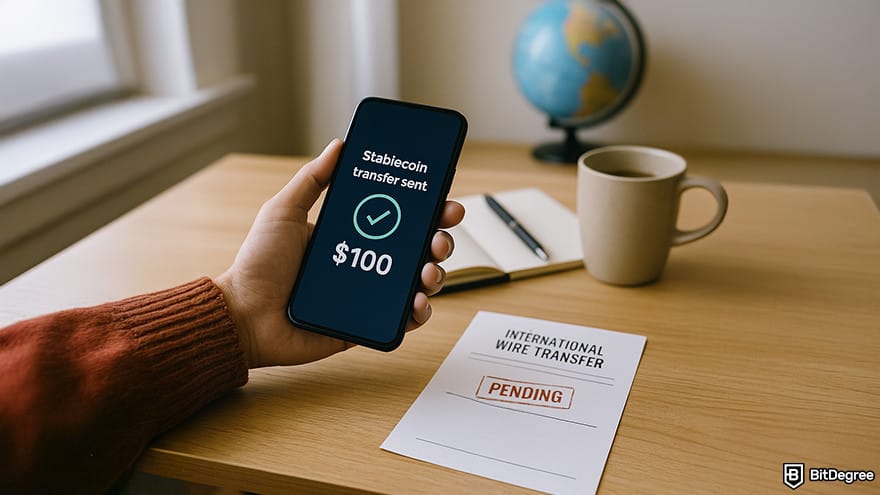
Businesses can also benefit from using stablecoins for cross-border payments and settlements. They can help reduce costs and accelerate transactions with international suppliers or customers.
Disadvantages of Holding Stablecoins
While stablecoins offer advantages, they are not risk-free. It's essential to understand the potential downsides before you decide to step further.
✗ Counterparty Risk
Some stablecoins are centralized, which means they’re issued and managed by companies. These companies hold the reserves that back the stablecoins in circulation, and you’re essentially trusting them to manage those reserves properly.
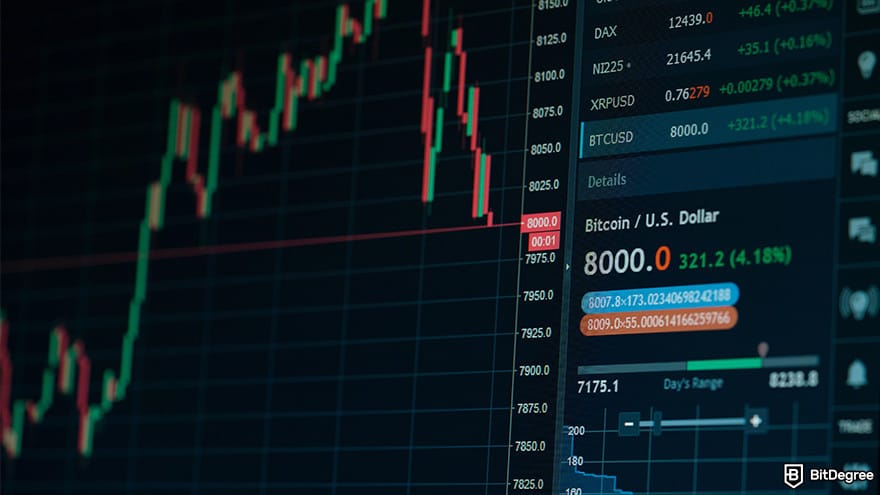
The potential risk here is that if the company fails to maintain sufficient reserves or runs into legal issues, the value of the stablecoin could be at risk. This situation is referred to as counterparty risk.
Even though most major stablecoins undergo regular audits and have solid transparency measures in place, it's still something you should think about.
✗ Regulatory Challenges
The increasing popularity of stablecoins has resulted in regulators all over the world taking a closer look at them. Governments and financial institutions are carefully examining these digital assets, and some are considering more stringent regulations.
The evolving regulatory landscape poses potential risks for stablecoin holders. They might have to follow stricter rules about how much money they need to keep in reserve, or they might not be able to use their stablecoins in certain places. These changes could also affect how easy it is to use or how much your stablecoins are worth.

If you're considering holding stablecoins long-term, it's important to keep an eye on regulatory developments. Changes in the rules could bring new risks that might make it harder for you to use or trade your stablecoins.
✗ Algorithmic Manipulation Risks
Decentralized stablecoins are usually governed by algorithmic systems, creating the risk of protocol manipulation. These complex algorithms designed to maintain stability may be vulnerable to flaws or attacks.
For instance, a cyberattack exploiting a glitch in the algorithm could lead to the creation of excessive stablecoins without the collateral. This incident can result in a loss of value across the ecosystem.

So, it’s important to conduct thorough research and seek out stablecoins that undergo rigorous audits and algorithm testing. By prioritizing stablecoins that are committed to transparency and robust algorithm protocols, you can significantly reduce your exposure to potential vulnerabilities.
Best Stablecoin Management Tips for Beginners
While understanding the benefits and risks is important, it’s equally crucial not to dive into stablecoins without a plan. Finding the best stablecoin options for you in the market requires strategic steps to make the most of your holdings.
So, let's cover some best practices to help you navigate the stablecoin space more effectively, whether you are using them as a store of value or participating in DeFi.
Tip 1: Strategic Diversification
Diversification is a fundamental principle in managing assets, and it’s just as important when it comes to stablecoins. While stablecoins are designed to maintain stable value, each operates differently and has its own risks and benefits.
If you’re considering stablecoins for storing value, diversifying your portfolio can be a smart move. It involves spreading out your portfolio across different types of stablecoins, avoiding putting all your funds in one basket.

You can also try to achieve optimal returns by balancing stablecoins with more volatile cryptocurrencies. By allocating a portion of your portfolio to higher-risk crypto with growth potential, you can capitalize on upward trends while mitigating downside risk.
Ultimately, the ideal diversification strategy will depend on your risk tolerance and financial goals. So, it’s important to assess your objectives carefully and choose a stablecoin allocation that aligns with your overall portfolio strategy.
Tip 2: Use Reputable Platforms and Secure Wallets
When it comes to where you keep and trade your stablecoins, it's important to choose a reliable platform. You want to make sure your assets are safe from any potential hacks, scams, or other security issues.
In this case, I'd recommend sticking with well-known exchanges like Binance, Bybit, or Kraken. These platforms have a proven track record and robust security measures to keep your assets safe.

Additionally, if you're planning to hold onto your stablecoins for a while, it's a good idea to consider storing them in a secure wallet—ideally, a hardware wallet like Ledger Nano X or Trezor Safe 5.
Hardware wallets are widely considered the most secure way to store and protect your digital assets. They ensure maximum security by keeping sensitive data offline, making it much safer from hackers, malware, and other online threats.
Tip 3: Monitor Regulatory Developments
The cryptocurrency space is always evolving, and so are the regulations surrounding it. Governments and organizations all around the globe are paying more attention to cryptocurrencies, including stablecoins.
Therefore, it's essential to stay in the loop about these changes because they can affect how stablecoins work and whether you can use them in your region.

For instance, new regulations might influence how stablecoins are issued or what assets can back them. This change can affect the stability and reliability of certain stablecoins.
Try to get updates from reliable crypto news sources or engage with crypto communities on social media. By keeping ahead of regulatory changes, you can adjust your strategy before your holdings are affected.
Tip 4: Keep Your Emotions in Check
Storing your funds in the form of stablecoins isn’t a stress-free experience. Market changes, new regulations, or sudden shifts in demand can make things uncertain and lead to emotional reactions.
Whether it's the urge to sell everything when the market dips or to jump on the latest stablecoin trend, emotional decisions can lead to regret.

So, it’s important to stay calm and stick to your long-term plan. Stablecoins are typically low in volatility, so treat them as a secure anchor for your portfolio rather than a high-risk gamble.
Try not to make sudden moves based on short-term market fluctuations. Keep in mind that the reason for holding stablecoins is to safeguard your funds by hedging against market volatility.
Conclusions
So, those are the best stablecoin options based on their popularity and insights from crypto experts. These coins not only offer stable prices and liquidity but also have various use cases, especially in the DeFi space.
Keep in mind that holding stablecoins isn’t entirely risk-free. That’s why it’s essential to diversify your holdings and use trusted platforms like Binance or Bybit for added security against cyber threats.
Additionally, always do thorough research, stay updated on market trends, and keep informed about the latest developments in the crypto space. Remember, you’re in it for the long run—don’t let market volatility lead to impulsive decisions that you’ll regret!
The content published on this website is not aimed to give any kind of financial, investment, trading, or any other form of advice. BitDegree.org does not endorse or suggest you to buy, sell or hold any kind of cryptocurrency. Before making financial investment decisions, do consult your financial advisor.
Scientific References
1. L. Ante, I. Fiedler, & E. Strehle: ‘The influence of stablecoin issuances on cryptocurrency markets’;
2. K. Ito, M. Mita, S. Ohsawa, et al.: ‘What is stablecoin?: A survey on Its mechanism and potential as decentralized payment systems’.
